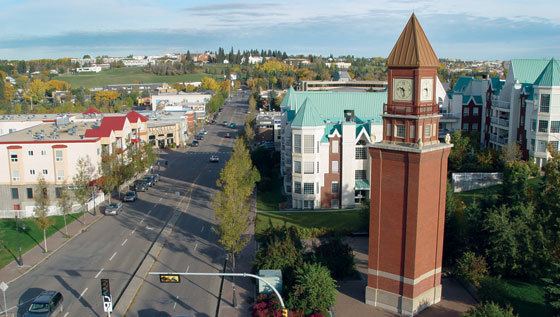Country Canada Area code(s) 780, 587, 825 Population 1.321 million (2016) | Time zone MST (UTC-7) Area 9,439 km² Province Alberta | |
 | ||
Postal code span T4X to T6X, T7X to T8R, T8T, T9E to T9G Highways 2, 2A, 14, 15, 16, 16A, 19, 21, 28, 28A, 37, 39, 44, 60, 100, 216 | ||
The edmonton capital region water management framework 2012
The Edmonton Capital Region (ECR), also commonly referred to as the Alberta Capital Region, Greater Edmonton or Metro Edmonton, is a conglomeration of municipalities centred on Alberta's provincial capital of Edmonton.
Contents
- The edmonton capital region water management framework 2012
- Edmonton CMA
- Capital Region Board
- Member municipalities
- Capital Region Growth Plan
- List of municipalities
- Major industrial areas
- References
The ECR's commonly known boundaries are coincident with those of the Edmonton census metropolitan area (CMA) as delineated by Statistics Canada. However, its boundaries are defined differently for Capital Region Board administrative purposes.
The ECR is considered a major gateway to northern Alberta and the Canadian North, particularly for many companies, including airlines and oil/natural gas exploration. Located within central Alberta and at the northern end of the Calgary–Edmonton Corridor, the ECR is the northernmost metropolitan area in Canada.
Edmonton CMA
The Edmonton CMA includes the following 35 census subdivisions (municipalities or municipality equivalents):
The Edmonton CMA is the largest CMA in Canada by area at 9,426.73 km2 (3,639.68 sq mi). In the 2011 Census, it had a population of 1,159,869, making it the sixth largest CMA in Canada by population. The Edmonton CMA comprises the majority of Statistics Canada's Division No. 11 in Alberta.
Capital Region Board
A fragmentation in regional cooperation and partnership has long played a divisive role within the ECR. Particularly, Edmonton was frustrated that its surrounding municipalities were receiving an increased tax base for major industrial development, while not contributing to Edmonton's burden to maintain and build new infrastructure within Edmonton used by the residents and businesses of the surrounding municipalities.
After pulling out of the Alberta Capital Region Alliance (ACRA), Edmonton lobbied the provincial government to establish some form of regional government that would be more effective in fostering regional cooperation between it and its surrounding municipalities. As a result, Premier Ed Stelmach announced in December 2007 that a governing board would be established for Edmonton's Capital Region. Four months later, the Capital Region Board (CRB) was formed with the passing of the Capital Region Board Regulation by Order in Council 127/2008 under the authority of the Municipal Government Act.
Member municipalities
The CRB was originally established with 25 participating or member municipalities – 23 of which were within the Edmonton CMA and two of which were outside the CMA (Lamont County and the Town of Lamont). The number of member municipalities was reduced to 24 on September 10, 2010 after the Village of New Sarepta dissolved to hamlet status under the jurisdiction of Leduc County on September 1, 2010.
Of the 35 census subdivisions within the Edmonton CMA, the Village of Spring Lake, the eight summer villages and four Indian reserves are not members of the CRB. Also, despite Bruderheim and Lamont being urban municipalities within Lamont County that are members of the CRB, the remaining urban municipalities within Lamont County - the Town of Mundare and the villages of Andrew and Chipman – are not members of the CRB.
More specifically, the CRB includes:
Capital Region Growth Plan
Under the CRB Regulation, the CRB was tasked with preparing a growth plan to cover land use, intermunicipal transit, housing, and geographic information services components. In March, 2010, Growing Forward: The Capital Region Growth Plan (CRGP), consisting of individual plans for these four components and two addenda, was approved by the Government of Alberta.
The CRGP includes a population and employment forecast for the Capital Region. With a base population of 1.12 million in 2009, the CRB has forecasted the population of the Capital Region to reach 1.31 million by 2019. However, the 2019 population estimate was reached and exceeded by 2014. The CRGP also designates priority growth areas and cluster country residential areas within the Capital Region.
List of municipalities
The following is a list of municipalities in the Edmonton Capital Region, all of which are also within the Edmonton CMA. The Town of Lamont, Lamont County and members of the CRB are indicated accordingly.
Major industrial areas
Major industrial areas within the ECR include the northwest, southeast and Clover Bar industrial areas in Edmonton, Nisku Industrial Business Park in Leduc County, Acheson Industrial Area in Parkland County, Refinery Row in Strathcona County, and Alberta's Industrial Heartland spanning portions of Sturgeon County, Strathcona County, Lamont County and Fort Saskatchewan.
At the moment, two more major industrial areas are in the final stages of establishment. The establishment of the Horse Hills industrial area in northeast Edmonton is in the final planning stages, while Edmonton Airports is currently planning its inland port development under the Port Alberta initiative at the Edmonton International Airport within Leduc County.
